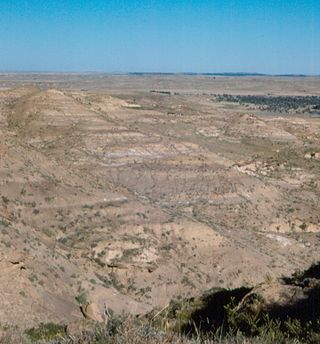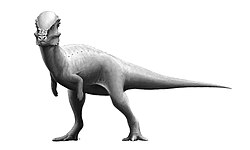Top Qs
Timeline
Chat
Perspective
Lance Formation
Geological formation in the United States From Wikipedia, the free encyclopedia
Remove ads
The Lance (Creek) Formation is a division of Late Cretaceous (dating to about 69–66 Ma) rocks in the western United States. Named after Lance Creek, Wyoming, the microvertebrate fossils and dinosaurs represent important components of the latest Mesozoic vertebrate faunas. The Lance Formation is Late Maastrichtian in age (Lancian land mammal age), and shares much fauna with the Hell Creek Formation of Montana and North Dakota, the Frenchman Formation of southwest Saskatchewan, and the lower part of the Scollard Formation of Alberta.

The Lance Formation occurs above the Baculites clinolobatus ammonite marine zone in Wyoming, the top of which has been dated to about 69 million years ago, and extends to the K-Pg boundary, 66 million years ago. However, the characteristic land vertebrate fauna of the Lancian age (which take its name from this formation) is only found in the upper strata of the Lance, roughly corresponding to the thinner equivalent formations such as the Hell Creek Formation, the base of which has been estimated at 66.8 million years old.[1]
Remove ads
Description
The formation is described by W.G. Pierce as thick-bedded, buff-colored sandstone, and drab to green shale. It is Upper Cretaceous in age.[2]
The formation varies in thickness from about 90 m (300 ft.) in North Dakota, to almost 600 m (2,000 ft.) in parts of Wyoming.
Depositional environment
The Lance Formation was laid down by streams, on a coastal plain along the edge of the Western Interior Seaway. The climate was subtropical; there was no cold season and probably ample precipitation.
Remove ads
Paleontology
Summarize
Perspective
At least tens of thousands of Late Cretaceous vertebrate remains have been recovered from the Lance Formation. Fossils ranging from microscopic elements to extensive bonebeds, with nearly complete, sometimes articulated dinosaur skeletons, have been found.[3] Most other animals known from the formation are freshwater animals, and some are exclusively freshwater forms (for instance, frogs and salamanders). However, marine fossils are also found in the formation, suggesting that the sea was nearby. The bird fauna is mainly composed of orders still existing today.
Coelurosaurs
Color key
|
Notes Uncertain or tentative taxa are in small text; |
Birds
Other coelurosaurs
An isolated tooth crown of an indeterminate coelurosaur is recovered from the formation.[13]
Ornithischia
Ankylosaurs
Marginocephalians
Ornithopods
Indeterminate lambeosaurinae fossils have been found in the Lance Formation.[35]
Other vertebrates
Other land vertebrates include pterosaurs (e.g. cf. Quetzalcoatlus),[38] crocodiles, champsosaurs, lizards, snakes, turtles, frogs and salamanders.
Remains of fishes and mammals (i.e. Nanocuris) have also been found in the Lance Formation.
Remove ads
See also
- List of fossil sites (with link directory)
- List of dinosaur-bearing rock formations
References
External links
Wikiwand - on
Seamless Wikipedia browsing. On steroids.
Remove ads















